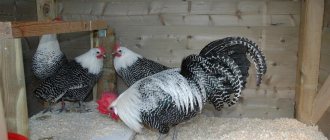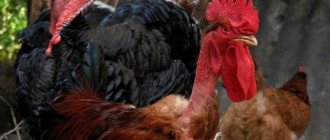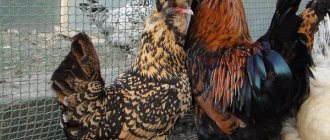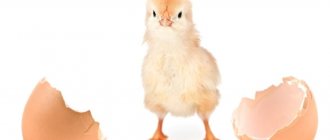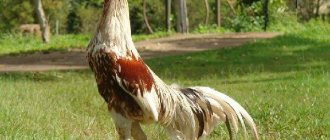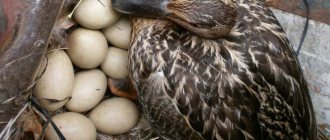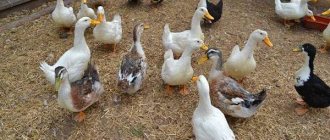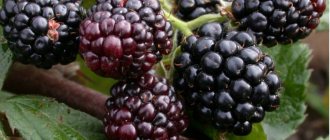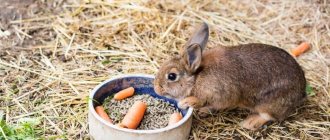Cultivation and maintenance
Individuals are easily tamed and friendly to children. The Dutch White-crested chicken breed is suitable for exhibitions where their well-groomed crests are displayed.
They never fight and rarely get along with other white-crested animals, which is why they are kept together. The Dutch white-crested chicken does not relate well to birds of other breeds, so it is better to provide them with a separate spacious enclosure.
The Crested Hen is vulnerable due to its reduced vision, so feathered pets must remain safe. If the tuft becomes wet and dirty, it hangs right in front of the eyes, interfering with vision, this leads to infections in the eyes and the inability to navigate in space. It is worth keeping the feeder and waterer clean and in the same place so that white-crested animals can easily find them again.
Dutch white-crested roosters are shy and are guided more by their voice than by their sight.
Dutch chickens get lost easily and start screaming, so it is important to keep them in a safe place.
The characteristics of the birds indicate that large crests are not just a warm hat for chickens, but also suitable breeding grounds for lice and other parasites. Birds are at much greater risk of ear mite infestation than other breeds. The ears are hidden under the tuft, so regular checks and appropriate spray treatments are recommended.
The Dutch chicken is not very hardy and easily catches colds, so it is kept under cover in humid weather. Some breeders even dry the tufts with a hairdryer if they get wet.
The characteristics of roosters and hens do not indicate resistance to frost. The birds have a thin skull, they suffer from hypothermia in cold seasons, despite the fact that they were brought from Holland - not the warmest country.
Advantages and disadvantages
The advantages of the Dutch white-crested breed include the following characteristics:
- outer beauty;
- good egg production;
- delicious meat;
- females are good brood hens.
White-crested chickens have their disadvantages:
- poor survival of young animals;
- weak immunity and susceptibility to disease;
- intolerance to dampness, cold and small spaces;
- demanding diet and living conditions;
- incompatibility with birds of other breeds;
- the need to care for the crest.
Nuances of breeding
Liven chickens in most cases are able to hatch chicks. The only problem is their weight - heavy quons often damage the eggs. For this reason, many farmers do not trust them with the responsible mission of breeding offspring, but use an incubator or a hen of a different breed.
For breeding, a rooster is selected whose exterior meets the standard. Preference is given to males with average weight. Too large heads of families during mating games injure the hens, which then leads to pecking.
Raising young animals
Liven calico chickens take a long time to fledge, so greenhouse conditions need to be created for them. Immediately after birth, the brood is placed in a brooder and in the first week of life is kept at a temperature of +30 ºС. The bedding inside is changed daily. After washing, the drinking bowl and feeder are scalded with boiling water.
Calico chickens are fed in the same way as representatives of other breed lines. Their first food is a boiled egg.
Then steamed small cereals, green onions, cottage cheese and vegetables are carefully introduced into the diet. Young animals are switched to whole grain feed at one month of age
Young animals of the Livensky breed
Breeding
The breeding process is conventionally divided into several periods, each of which has its own characteristics and nuances. Knowing such points makes the entire process of poultry breeding easier.
Puberty and oviposition
You can start breeding birds immediately after they reach sexual maturity. The onset of such a moment can be determined by the beginning of egg laying. In most cases, it begins at 6 months of age for the hen.
Despite the fact that the hen begins to lay eggs, she cannot stabilize this process for a long time and farmers are unable to determine any clear schedule. Oviposition begins to stabilize only 20-30 days after the first egg is laid.
Choosing eggs for chicken breeding
Hatching eggs
After the first eggs have appeared and the process of laying eggs has its own schedule, you can begin to select them for breeding. Although in most cases it is not necessary to take the laid eggs from the hen, since the white-crested breed, in addition to its beautiful decorative appearance, has a good ability to care for its offspring and hatches eggs without problems.
According to statistics, only 10% of all crusts fail to cope with their responsibilities. During the laying period, it is strongly recommended to isolate them from eggs, since they can harm the unhatched offspring. Even taking into account the fact that chickens have a bad temperament and are very aggressive towards other birds, this does not in any way affect the treatment of chickens. In relation to them, adult chickens behave reverently and take decent care of their offspring.
Babies are born somewhere in 21-24 days.
Mother hen. Preparing a place for hatching, creating conditions for the chicken
Caring for a hen
During the period when the mother hen begins to hatch eggs, it is very important to provide her with decent care, which consists of the following points:
- a few days after the hen has laid an egg and began to hatch it, under no circumstances should she be disturbed or forced to leave the nest. If you disturb the hen during this period, she may no longer return to the brooding process;
- however, it is worth monitoring the hen regarding the time she spends in the nest and, at least once a day, giving her the opportunity to leave the nest for eating, drinking, bathing and short walks;
- if the bird does not want to leave the nest on its own, then it is carefully removed and released for a walk. At the same time, the passage to the nest is closed, since the chicken can immediately return to it;
If the hen leaves, you need to close the nest, otherwise another “hen” may appear there.
- at the moment when the hen goes for a walk, the eggs in the nest are covered and thus kept warm. One walk should not take more than 20 minutes. If the hen walks longer, this promises hypothermia of the eggs, so in this case the hen is forcibly returned to the nest;
- when the hen leaves the nest, then at this moment they must inspect the eggs, throw out damaged ones and replace the dirty bedding;
Chicken eggs in the nest
- For the convenience of the bird, it is recommended to install an additional feeder and a container of water near the nest. This will ensure she has unhindered access to food and water around the clock;
- During the hatching of eggs, the chicken is checked for the presence of parasites. This technique makes it possible to eliminate pests in time and prevent them from harming the birds.
Prices for a nest for laying hens
Nest for laying hens
The appearance of chicks
Once the chicks start hatching, don't touch the eggs, even if you really want to look at them.
After the chicks appear, the hassle usually increases. This is due to the fact that the survival rate among the new generation of chickens is very low, amounting to only 70%. After birth, the chicks are very weak and small. Their color depends on the color of the plumage of their parents. Most chicks do not have a good appetite and high activity - this is the reason why food for chicks must be enriched with vitamins and special preparations that prevent the development of infection in the chicks’ bodies.
After the chicks are born, they are taken away from the mother hen for a while into a separate cage or a special poultry house. In the future, they are engaged in cultivating them independently.
Dutch white-crested chickens
The rules that are followed when caring for the new generation are as follows:
- for feeding young animals, the same food is suitable as for hens, but it is necessary to ensure that the young animals eat food strictly at certain hours;
- a prerequisite for feeding is the use of only fresh products;
- Every time after eating, the feeders for the chicks are immersed in a disinfectant solution. Leftover food is a good environment for the development of pathogenic microorganisms that can cause diseases in weak young animals;
- the temperature in the chickens’ habitat must be stable and be 26-28 degrees, otherwise the chickens can easily become hypothermic and get sick;
- It is very important to provide the young generation with dry and clean bedding; wet bedding is a source of bacteria that cause diseases in poultry.
How to care for chickens under two months old
Prices for a brooder - a cage for raising chickens
Brooder - a cage for raising chickens
When the chickens have grown a little and become stronger, they can be released into a common poultry house, where the hen will take care of them in the future.
Hen and chicks
When white-crested chickens appear, it is worth keeping in mind that even if all the specified recommendations and rules are followed to ensure proper care of the offspring, there will be a certain percentage of babies that do not survive. This is directly related to the breed itself, which was obtained by crossing two varieties of chickens. Such breeds always have health problems and are very sensitive to environmental conditions.
White-crested chickens
Description and characteristics
The chicken variety was developed in the 16th century and its origins are quite unusual. Initially, a breed called the Corydalis was bred in Holland. At that time, she had no resemblance to the current white-crested hen. Corydalis were bred in Holland to produce more meat and eggs. In appearance it was an ordinary chicken, but with black plumage, which was often interspersed with red feathers.
A little later, scientists who decided to turn the Dutch Corydalis into a breed bred for decorative purposes crossed it with the Polish Corydalis chicken. The result was the current breed of white-crested chicken, which began to be used not only for obtaining eggs, but also as an ornamental bird.
Dutch white-crested chickens and rooster
The white-crested breed can be characterized as follows:
- the bird's skull has a swelling on which a white crest is located. The genetic purity of chickens is usually determined by this crest;
- the presence of feathers at the base of the beak. The color of these feathers matches the main plumage, their arrangement gives this area the shape of a butterfly. A prerequisite for the purity of the breed is the splendor of the crest and its spherical shape. It is unacceptable for a chicken to have feathers of a different color on its head;
- the color of the beak and legs always matches the color of the main plumage;
- the eyes are red or brown, and the earlobes are white;
- roosters are distinguished by a narrow tail, which consists of wide curved braids of hooked feathers. The tail is positioned at an angle of 45 degrees relative to the body.
Rooster of the Dutch white-crested breed
You can see what hens of this breed and their chicks look like in this video, as well as pay attention to their special features and conditions of detention
Video – Dutch white-crested
Regarding the productivity of the white-crested variety, there are certain indicators. It is considered more of an egg breed than one that is used for meat. It is possible to breed such birds for meat purposes, however, because of their beauty, few people want to kill them for food.
Chickens are bred for decorative purposes
The productivity of the breed is up to 140 eggs in the first year of life, in the future it is capable of producing 100 eggs. The eggs are slightly smaller compared to a regular breed of chicken, weighing no more than 50 grams. The egg shell is white. The period of productivity begins after six months of the chicken’s life. Regarding the weight of the carcass, roosters can gain weight up to 2.5 kg, and laying hens up to 2 kg.
The weight of a white-crested chicken can reach two kilograms
Dutch white-crested chickens
The Dutch white-crested breed of chickens has a very interesting and unclear origin. In the Russian-speaking space it is called Dutch; in the Netherlands and the rest of Europe it is often called Polish. Chickens similar to Dutch White-crests have been depicted in paintings since the 17th century, but the exact origin of this breed is unknown.
There is a version that the Dutch originally bred very productive chickens for meat and eggs. At that time, the breed from the Netherlands did not resemble the modern one. But it laid a colossal number of eggs for those times and produced good meat.
Later, a crested chicken was brought from Poland and crossed with productive Dutch ones. The final result of the crossing was the modern Dutch white-crested chicken, which became possible to use not only as a productive bird, but also as an ornamental bird.
Diseases of the breed
Long-term selection of the breed allowed the Sussexes to acquire stable immunity to most poultry diseases. However, the danger may be:
- Coccidiosis. Symptoms include weakness and bloody diarrhea. Treatment involves slaughtering sick individuals and treating the rest of the herd.
- Mycoplasmosis. The disease is caused by a combination of humidity and ammonia in the absence of ventilation in the room. A symptom of the disease is a severe cough. Treatment is carried out by inoculating with a special vaccine.
Parasites such as lice, lice, roundworms and salmonella are also dangerous. To prevent infection, it is necessary to carry out preventive disinfection and disinsection of premises.
https://fermhelp.ru/kury-susseks/https://webferma.com/pticevodstvo/kuri/porodi/myaso-yaichnie/sussex.htmlhttps://xn—-7sbabudf4czbg.xn--p1ai/opisanie-kur- porody-sussex-pravila/
Feeding an adult herd
In general, hens can be content with the products they are given. But, there are several important rules for feeding adult livestock. Let's look at them.
- The winter diet should differ from the summer diet in increased calorie content and an additional portion of vitamins. We must not forget that even during this difficult period, the laying does not stop, so the ratio of proteins, fats and carbohydrates remains the same.
- In winter, the need for vitamins increases due to the impossibility of walking on green lawns, where black clumps partially met their needs in the summer season. You can enrich the menu with dry herbs, vegetables, as well as the use of special preparations that contain the whole range of useful substances.
- The entire daily feed intake should be divided into 3 meals. If it's summer and birds are grazing on lush, green lawns, the daily meal can be canceled.
- The quality of grain and the composition of grain mixtures should be strictly controlled. If a combined industrially produced feed is used, it should contain the following grains: wheat, oats, corn, rye, barley.
- Important mash is an ideal option for quick saturation, as well as for enriching birds’ bodies with minerals, vitamins, fatty acids and proteins. Such delicacies are prepared using broths, skim milk, or simply steamed with boiling water.
Diet
The breed is quite picky when it comes to food, although the bird needs little food.
Dutch white-crested chickens should not be fed dry food or grain alone.
Feeding the breed has some features that must be taken into account:
- Dutch crested cats have poor digestion, so it is recommended to feed them wet food at least once a day. You cannot keep the breed on dry grain!
- The diet is based on grain mixtures (rye, oats, barley, wheat) and industrially produced feed.
- The diet of corydalis also includes legumes, corn, and greens.
- The daily diet of poultry should contain fats of vegetable origin, without which it is impossible to preserve the appearance of the bird.
- In the cold season, the amount of food is increased, vitamins and minerals are added to it.
- In spring, carbohydrates should be present in the diet.
- Root vegetables and vegetables make up 30% of the daily menu. They are given boiled as part of mash from mixed feed or separately.
- The breed requires a standard set of additives for egg-laying chickens: fish oil. Chalk, meat and bone meal, flaxseed. The amount of additives is taken from special tables for all egg breeds of chickens.
In the cold season, the amount of food is increased, vitamins and minerals are added to it.
Hens - laying hens of the Dutch breed "Hisex"
No one will undertake to count the exact number of chicken breeds currently existing, but, according to experienced poultry farmers, there are already more than seven hundred (!) species in the world.
Chickens of the " Hisex"
"are not an independent breed, but were obtained by Dutch breeders on an agricultural basis by crossing two species of birds:
· «Leghorn
"(an egg breed bred in Italy)
· «New Hampshire
"(American breed of chicken meat - egg type with white feathers. Bred with the participation of the
Rhode Island
)
Initially, back in the Soviet Union, these chickens were purchased and tested at one of the poultry farms in Ukraine, where very impressive results were obtained, after which the hybrid began to actively spread in the Urals, the North Caucasus and Siberia.
In total, the Dutch bred two varieties of “ Hisex”
”, which differ in plumage color: White (
White
) and Brown (
Brown
).
The white hybrid initially had higher popularity among poultry farmers, but over time Brown overtook it due to its higher productivity and dark brown egg color.
Features of Hisex chickens
Looks like a " Hisex"
" is not catchy. The chicken has a neat body, a rather large comb that hangs coquettishly to one side and smooth, silky feathers that are pleasant to the touch. Poultry farmers fell in love with the cross not for its beauty of appearance, but for the fact that these chickens are easy to raise both on homestead farms and on an industrial scale, and in terms of the ratio of costs to profit received, this breed is still considered one of the best in the world.
It is noteworthy that with a very modest size and weight of up to two kilograms, laying hens produce fairly large eggs, the average weight of which is approximately sixty grams. At the same time, the productivity of one hen reaches three hundred and twenty (!) eggs during the year, and a laying hen provides such high productivity for two to three years.
Laying hens are distinguished by their fairly early puberty, high survival rate, and good disease resistance. Among other things, chickens of the “ Hisex”
"Very friendly, sociable, active and energetic.
Already at one day of age, hens and cockerels of this hybrid are easy to distinguish from each other, since the cockerels have lighter down.
As for keeping cockerels, it is better not to keep them at home for a long time, but to let them eat meat, since over time, it loses its taste and becomes tough.
Features of the Hisex Brown breed
Laying hens of the breed " Hisex Brown"
"are also of the egg type and have an eye-pleasing brown-gold plumage. Unlike their white relatives, they have a larger body and with greater consumption of feed, chickens gain weight faster.
The breed is quite hardy, unpretentious to food, not demanding on living conditions and acclimatizes well.
Unlike its white relative, the brown chicken is more phlegmatic and calm.
Dutch white-crested chicken breed
other parts:
Ga Dong Tao - the rarest breed of chickens
Chickens Phoenix
Chinese silk chicken
Chickens of the Brahma breed
Barnevelder chickens
Cochin chickens
Chickens of the Andalusian Blue breed
Dutch white-crested chickens can be an excellent decoration for a personal backyard. The extravagant appearance of these beauties attracts not only beginners in poultry farming, but also experienced farmers.
In addition to their beautiful appearance, Dutch white-crested chickens have good egg production and very tasty meat.
Origin of Dutch white-crested chickens
Beginning in the 16th century, unusual-looking black chickens appeared on the canvases of Dutch painters, their heads adorned with a luxurious white crest. But a century earlier, these birds were ordinary black chickens. The breed was distinguished by good egg production and fully satisfied the needs of poultry farmers. However, poultry farmers wanted to decorate black chickens, and for this they began to cross them with the Polish white crested chicken. As a result of an experiment by breeders, a black chicken acquired a white crest. True, the productivity of the breed has decreased somewhat. At the same time, the acquired exotic external qualities ensured the popularity of the breed. The crested Dutch hen has become a kind of symbol of the country and a decoration of many estates of the nobility.
Description of the breed of Dutch white-crested chickens
Dutch white-crested chickens weighing from 2 to 2.5 kg. (chicken no more than 2 kg, rooster – 2.5 kg).
The body is compact, the belly is well developed, the legs are of medium length and graceful. The plumage is tight-fitting and does not form cushions. On the “face” of the chicken, feathers are almost completely absent; it has a reddish color.
The chicken's skull is swollen, and there is a lush, dense and fairly large crest on it. Their physical purity is usually determined by their genetic purity, which is why it is the custom of the owners of birds of this breed to wash the heads of their charges. The crest is positioned so that the bird's eyes are not obscured. The feathers on the forehead are black and their arrangement resembles a butterfly. The pattern of these feathers determines the high breeding of the bird. The purity of the breed is also determined by the color and size of the crest. It should be pure white and large in size, especially for roosters.
The breed does not have a comb. Roosters have large earrings, bright red. The bird's earlobes are small and white. The beak is small, matching the plumage. The eyes of corydalis are red-brown or pure red.
Unacceptable faults are the small size of the crest, its irregular shape (looseness, parting), and the presence of feathers of a different color. The presence of a crest, absence of cranial swelling, and yellow or green metatarsals also lead to disqualification.
The color of the Dutch white-crested chicken breed is allowed in three types:
Productivity of the Dutch white-crested chicken breed
A laying hen produces from 100 to 150 eggs per year, i.e. The breed is moderately productive.
The egg is white, weighing 40-50 grams. A hen hatched in March begins to lay eggs in September. First-year laying hens are the most productive . From the second year, egg production decreases to 100-110 eggs.
Advantages and disadvantages of Dutch white-crested chickens
1. Dutch white-crested chickens are very beautiful.
2. They fly well.
1. Dutch white-crested chickens do not tolerate chickens of other breeds around them.
2. Low immunity, susceptible to diseases.
3. Very demanding regarding living conditions.
Keeping Dutch white-crested chickens
The Dutch Crested hen is an individualist and does not tolerate being around chickens of other breeds. This feature must be taken into account when organizing the keeping of chickens. For them you need to prepare a separate chicken coop with a spacious enclosure.
The chicken coop for them should be dry and clean. In winter, they are kept only in heated rooms.
Once a week they need to wash the tufts on their heads, otherwise they begin to turn yellow.
The breed is very fussy by nature. Birds are constantly fussing around, rushing somewhere, always looking for something. At the same time, they are shy and sensitive, and become attached to their owner. At the same time, in their family, birds are distinguished by their unity and friendliness towards each other.
Roosters do not fight among themselves, so you can keep several of them in one coop. But when a stranger appears, the leaders fearlessly defend their own territory and chickens.
Breeding white-crested chickens is also difficult because the chickens are even more susceptible to disease than their mothers. For no apparent reason, up to half of all young animals may die. Chickens of this breed of chicken must be treated with care, fed on time, and kept in a warm and dry room. If this is not done, then none of the newborns have a chance to survive.
Feeding the breed of Dutch white-crested chickens
1. Digestion of Dutch white-crested chickens is weak, so it is recommended to feed them with wet food at least once a day. You cannot keep the breed on dry grain!
2. The basis of the diet is grain mixtures (rye, oats, barley, wheat) and industrially produced feed.
3. The diet of Dutch white-crested chickens must include legumes, corn, and greens.
4. The daily diet of poultry must contain fats of vegetable origin, without which it is impossible to preserve the appearance of the bird.
History of the breed
Livensky district existed in the Oryol region back in Tsarist Russia. It was then that ordinary peasants tried to breed chickens for themselves that would lay large eggs all year round. The thing is that in those days ordinary people could afford to feed the bird with just a handful of grain.
Over the years, the peasants managed to get what they wanted. At the same time, the Livenskaya breed of chickens grows very quickly and lays eggs throughout the year without interruption. In those days, eggs of this type were popular in England, where they were supplied from Russia. Liven calico chickens can be distinguished by their plumage.
Unfortunately, in the sixties it was decided that this breed was not profitable, since there were more productive breeds. As a result of this, Calico chickens began to be exterminated. The only exceptions were private farms. It was already impossible to restore the livestock.
In recent years, the Liven Calico breed of chickens was discovered on a private farm in the Poltava region. Over the course of several years, they began to actively breed them and select only the largest and strongest individuals for the reincarnation of the species. Now experts assure that Livenka will soon again be famous throughout Russia and abroad. To have an idea of what we are talking about, you should consider the description of the Liven chicken breed.
Birth and development of the breed
The white-crested breed is an ornamental species that was bred by Dutch breeders, and at the same time is included in the meat and egg group of poultry.
The versatility of the breed also lies in some of its maintenance features. It is not recommended for breeding for beginners.
So what about the roots of the breed? Images of these beautiful chickens and roosters are found in the paintings of Dutch painters of the sixteenth century. Written references to the breed date back to the fifteenth century, when it was dark in color with red patches. Everything suggests that they were originally bred for meat and eggs.
Scientists suggest that the white-crested chicken is related to the Polish crested chicken breed. They are united by a shaggy cap on their heads. The decoration was added precisely from the Polish sisters. Egg production has noticeably decreased; in return, a white crest of long feathers was obtained, giving the chicken a special chic.
Thanks to its exotic appearance, the chicken has become a symbol of the country, the calling card of many farmsteads and estates.
Further work of breeders was aimed at increasing the productivity of the beautiful breed.
Description and characteristics of the Goloshka breed
The main distinguishing feature of these birds is the absence of feathers on the neck, crop, under the wings and on the inner sides of the legs. These areas are called apteria and have clear standards. Birds do not lose feathers; contrary to popular belief, they are already born with underdeveloped follicles in these areas of the body.
But on the back of their heads they have a chic feather bow or cap, and in front they have feathers folded into a fluffy collar. The genetically determined “naked neck” is a dominant trait that is necessarily passed on to the chicks if the purity of the breed is maintained.
Speaking about the breed, it should be noted that at poultry exhibitions, these chickens always gather enthusiastic onlookers around them, and quite strict requirements are imposed on their exterior; judges can reject chickens for the following reasons:
- yellow skin in the apterial areas is a sign of the presence of genetic abnormalities and hereditary diseases.
As for the tail, the standards describe its location as “at an angle of 15-20 degrees,” however, deviations at this point are very common. For the first time, professional poultry breeders and farmers encountered this breed at an exhibition in Vienna in 1875, and by 1930 these chickens had already spread throughout Europe, including part of the territories of the USSR.
Of course, the leadership remained with the less exotic, familiar-looking laying hens, but nevertheless, already at that time, bare-necked hens had a circle of admirers, which only expanded from the beginning of the 20th century. The reasons for the ardent love of many farmers for this bird are not its appearance, but such qualities of the breed as:
- high and early egg production;
- absolute unpretentiousness in maintenance - the bird will even survive the absence of a poultry house;
- complete indiscriminateness in food - blacknecks feed on everything that comes under their beak;
- easily tolerates any weather conditions, including frosts - barenecks will never refuse a walk in the snow, but at the same time they feel great in the tropics.
In addition, the bird is quite large and its meat has all the qualities that can satisfy even gourmet gourmets. For example, it was these chickens that began to be supplied to the imperial court in Russia in 1911.
Such characteristics of bare-necked chickens indicate the complete versatility of this breed, as well as their unique exotic appearance, in which. In addition to the bare neck, the bright, varied colors of the available feathers also play a significant role, making the bird very popular both among poultry farmers practicing selection and among ordinary businessmen. As for the productivity characteristics of the breed, bare-necked chickens differ:
- good weight, roosters from 3 to 4 kg, hens from 2 to 3 kg;
- early and stable egg production, on average from 160 to 200 eggs per year;
- large mass of eggs for any diet, from 57 to 62 g;
- The first “adult” egg laying begins at 24-25 weeks of the hen’s life.
Breeders reviews
Olga. The breed requires maximum attention and experience in breeding. I do not advise beginners to have such chickens: this bird needs a lot of attention. They also grow very slowly. The chicks are literally like sparrows for the first 3-4 months. Roosters are just hilarious. They show off and crow from 4 months. They lay well, but the eggs are small, almost like quail eggs.
Alyona. Small decorative chickens. They are terribly shy, but they become attached to their owners like dogs. I advise you to cut your forelocks, they see poorly because of them. I trim the feathers around the entire forehead with mine. You can't get meat from them. Roosters are wayward. But the chickens are downright tame. I take them on my knees and stroke them. When you approach the enclosure, you need to give a voice so that they don’t get scared and know that the owner is coming.
We invite you to look at the Dutch White-crested chickens in the video. We wish you pleasant viewing!
Features of cultivation
To raise birds, the chicken coop must be spacious and insulated so that the birds are not harmed by severe winter frost. Install the perches at a height of no more than 100 cm from the floor surface. Due to its dense plumage, the bird is not afraid of slight drops in temperature, but during severe frosts it is recommended to turn on the heating in the pen.
The bedding layer in the chicken coop must be replaced at least once a year, and the walls must be covered with a protective layer of slaked lime. Be sure to add hay to the nests every 30 days. Using antiseptic agents, systematically wash feeders and drinkers once a month or if there is heavy contamination.
Other aspects of care consist of regular feeding and parasite control. We must not forget that you need to collect eggs, because if birds try the shell once, they will systematically peck at them to feast on them.
As for feeding, it is recommended to use the same food. During the summer season, chickens can be sent to free range, and standard feeding (compound feed) can be reduced to a minimum. During walks, birds feast on worms, insects, grass or plant seeds. In order to determine whether a bird is full or not, you can palpate its crop. If it is full, you don’t have to worry about the chicken being hungry, but the presence of an empty or weakly filled crop indicates that the bird is starving.
The normal condition of the chicken is maintained by feed. In the winter season, birds need to be fed with grass flour, grain mixtures, whey, wet mash, meat or fish waste and vitamin and mineral complexes. The chicken should eat one serving within half an hour. You can use waste after cooking for feeding, but only if it is not rotten or sour.
The maternal instinct of Pavlovian hens is very strong; the hen can take the initiative and sit in the nest herself. In order for chickens to hatch, farmers recommend placing no more than 10 eggs under a chicken. When raising chicks, the Pavlova hen will protect them, preventing the loss of the young. Feeding chickens should be started only after they are completely dry. You can hard-boil an egg, chop it into small pieces along with the shell and feed it to the chicken.
You should also include corn and crushed wheat grits in the diet of young animals. It is recommended to stop heating Pavlovian chickens when they reach the last stage of plumage, which occurs 50 days after birth.
Feeding the birds
The diet of Dutch women differs in quantity, but is quite similar in composition. The white-crested breed is the most fastidious, and the food prepared for it is completely suitable for other breeds. Three meals a day consist mainly of wet mash (minimum 30%).
Features of the diet are:
- for egg-bearing breeds, industrial mixtures that contain an optimal selection of grains, fats and fiber are suitable;
- food should contain fats, which not only improve plumage, but also strengthen the immune system;
- in winter, food should include more vitamins, which birds can get from fresh greens in spring;
- food additives (chalk, bone meal, fish oil, flax seeds, etc.) are added according to the nutrition tables for a specific breed;
- 30% of the diet should be boiled vegetables.
Description
After they stopped demanding a large number of eggs from the Dutch White-crested and put an emphasis on beauty, egg production most likely decreased. Or has not risen since the Middle Ages. Today's productive characteristics of Dutch white-crested chickens are at an average level for meat breeds, while the white-crested chicken itself is considered a meat-egg breeder.
Over the past centuries, the crest has undergone some changes towards greater elegance. But initially the breeders overdid it a little. The chickens did not have a particular problem with the crest. It became lush and spherical. The roosters' comb began to droop to one side. In general, due to the too much pomp of the crest, the chickens’ vision began to suffer. Eventually, the Dutch Poultry Association tightened the standard, requiring that the crest and crest be proportional to the size of the bird. For breeding work, it was recommended to select roosters with a powerful, medium-sized standing comb.
Standard
The Dutch white-crested rooster weighs about 2.5 kg. Chicken from 1.5 to 2 kg. In the dwarf version, the rooster weighs 850 g, the hen 740 g. The productive egg characteristics of the Dutch white-crested chicken breed are low by today's standards: 140 eggs per year and the weight of one egg does not exceed 50 g. The shell is white.
Today, the main attention is paid to the appearance of these chickens, which have already firmly become decorative. The White-crested body has a compact body. The comb of roosters is often not visible under the feathers and gives the impression that it is missing
In fact, a purebred rooster has a red comb, although it is hidden. The ridge shape is V-shaped. The earrings are red, the earlobes are white. The eyes are red or brown. The color of the beak depends on the plumage of the bird. The color of the beak and tarsus matches the color of the bird
The comb of roosters is often not visible under the feathers and gives the impression that it is missing. In fact, a purebred rooster has a red comb, although it is hidden. The ridge shape is V-shaped. The earrings are red, the earlobes are white. The eyes are red or brown. The color of the beak depends on the plumage of the bird. The color of the beak and tarsus matches the color of the bird.
The skeleton is light. The body is compact, located almost horizontally relative to the surface of the earth. The wings are small, tightly pressed to the body. The abdomen is tucked and well developed. The back is straight. The tail is located almost vertically, of medium density, narrow. Roosters are decorated with long braids running along the inside of the tail. Legs of medium length. Metatarsus unfeathered.
Breed Features
In the description of Dutch white-crested chickens, there are signs by which the purebred bird can be determined:
- there is a swelling on the skull, on which the famous crest grows;
- at the base of the beak long feathers grow, matching the color of the main plumage; these feathers form a butterfly or whisker pattern.
Today, chickens have been bred with other color options. Russian-language sources in the description of the Dutch white-crested chicken breed insist on a maximum of two varieties of colors: black and lavender - a derivative of black. In fact, a black body with a white crest is simply the most common color option for the Dutch White-crest. Foreign sources provide photos of Dutch white-crests with quite a wide variety of colors. And sometimes even without a white crest.
In the photo in the background.
And the most paradoxical-sounding color of the Dutch white-crested dog is black.
White
Available in a Dutch pet store.
One should not be surprised at the presence of white and black colors, since these genes responsible for these colors are definitely present in the original Dutch white-crested breed with a black body and a white crest. Although, considering the pictures with white and red crested chickens, we still need to think about what the original color is.
Advantages and disadvantages
Pros: very beautiful appearance.
And now about the shortcomings. The main drawback is the crest. As you can see in the photo of Dutch white-crested chickens, the feathers of the crest are very long and cover the chickens' eyes. When wet, feathers become heavy and droop. In winter, they often freeze. In order for the tuft to be beautiful and white, it must be washed. Food sticks to the feathers of the crest, which leads not only to feather contamination, but also to problems with the eyes.
Chickens are very nervous and shy. They tolerate stressful situations very poorly. You cannot approach them suddenly. These chickens must see the approach of a person in advance.
These chickens often have intraspecific conflicts, during which they can easily pluck feathers from the crest. Also, feather eaters often appear in the Khokhlo and chickens must be periodically checked for the presence of parasites.
They are fussy and unable to get along with other breeds. Very susceptible to diseases due to weak immunity. Demanding about conditions of detention.
Description of the breed
Dutch white-crests are distinguished by a small head with a wide forehead and bright large earrings, more developed in males. The comb is missing. Eyes brown or red. The earlobes are small, white. Chickens of this breed have a medium-sized beak, the color of which matches the plumage. The body is small, with a protruding chest and a straight back. Birds have thin legs of medium length, the color of which matches the color of the beak. The wings are small and tightly pressed to the body. The tail of roosters is set high and feathered with thick coverts and flattened feathers.
The main difference of the breed is its white crest, voluminous and spherical in shape. Its front feathers, located on the forehead, are colored in the color of the main plumage and are shaped like a butterfly. .
The color of the chickens can be dark or light, in accordance with the parent. The plumage is downy, with possible light and dark inclusions. Paws are pink, gray or mixed colors. The beak is yellowish. The chicks have a characteristic protruding crest on their heads.
Birds of this breed have a difficult character - they are fussy and restless, and do not get along well with representatives of other breeds . It is advisable that the birds see in advance that the owner is coming towards them - this will save the birds from additional stress.
Dutch Cresteds cannot survive and reproduce without human help, as they have weak immunity and are sensitive to living conditions. Chickens require additional care.
Birds have not lost their brooding instinct during the selection process, so they are able to hatch their offspring independently. These qualities are manifested in 90% of chickens of this breed . Females take care of the chicks themselves after hatching, however, the survival rate is only 70% even with proper care.
Hatching and caring for chicks includes several important rules . During incubation, chickens that have lost this instinct should be removed from the premises. Hens should be checked regularly for parasites. Chicks hatch 20-25 days after laying. It is important to provide the chicks with clean, dry bedding. It is necessary to carefully monitor their health and not forget about vitamins and disease prevention. For chickens, a temperature range of 26-28 °C is important.
Birds reach sexual maturity at approximately 6 months of age . At this time, chickens can be purchased for breeding. It is recommended to carry out planned replacement of the herd every 2-3 years. With longer maintenance, not only the performance, but also the health of the birds deteriorates.
Advantages:
- beautiful external data;
- good egg production indicators;
- preserved brooding instinct.
Flaws:
- low level of immunity;
- complex nature;
- demanding conditions of detention.
The breed has no crosses.
Birds of this breed are raised exclusively for decorative purposes, as well as for producing eggs. Dutch white-crests are too beautiful for slaughter and do not have sufficient weight - the weight of a rooster varies from 2 to 2.5 kg, and the weight of a chicken varies from 1.5 to 2 kg.
The egg production indicators of Dutch White-crested White-crests are outstanding among ornamental breeds. In the first year of laying, the number of eggs reaches 130-140 eggs per year, and in subsequent years it decreases to 100. The weight of eggs is from 40 to 50 grams.
Features of cultivation
Statistics show that with normal care, the survival rate of chicks is quite high and reaches from 90 to 95 percent
Considering that the metabolism of Cochins is slow (like all meat crosses), it is important that the chicks do not overeat
You can also prepare your own fortified mixture for raising birds.
The recipe is:
- 0.5 liters of sunflower oil;
- 2 tsp vitamin D2; – 2 tsp. vitamin E;
- 2 tsp vitamin A.
Mix all. Be sure to keep the resulting mixture in the refrigerator. Vitamins can be purchased at the pharmacy in the form of oils. For 1 kg of feed it takes 1 tsp. the resulting oil. For more efficient growth of Cochins, you can feed them with industrial feed. They are better balanced and give the desired result faster. These feeds contain all the vitamins and proteins necessary for the body of meat chickens.
Healthy young animals are the key to raising strong adult chickens
Therefore, it is important to provide good care, an established routine and a balanced diet from the first days of life. Do not introduce new foods ahead of time
You need to wait for the required stage of development of the chickens’ gastrointestinal tract.
It is necessary to comply with the established volumes of food, since Cochins are prone to obesity, and we need high-quality meat. This breed of bird is not picky compared to many other crosses, so with a little hard work and dedication, you will be able to achieve the desired result.
If you find an error, please select a piece of text and press Ctrl+Enter.
https://mnogo-krolikov.ru/kury/xarakteristika-kur-porody-koxinxin.htmlhttps://7ogorod.ru/domashnyaya-ptica/kohinhin-poroda-kur.htmlhttps://selo.guru/ptitsa/kury/ porody/myasnie/kohinhin/tsyplyata.html
Features of breeding
Breeding Dutch Crested chickens is not easy. The survival rate of chickens is extremely low, even if all maintenance recommendations are followed. Immediately after purchasing or hatching, chicks need to be cared for like small children. Crested chicks are tiny and very weak.
[adsp-pro-6]
The air temperature in the room where they are located should be 23-26 degrees. Chickens should always have clean water, dry bedding, and room to walk. Wet litter is a source of infection. One infected chicken will immediately destroy the entire brood. They need to be fed strictly according to the clock, following the recommendations for the diet of young animals.
Important. If you notice that a chick is not feeling well, you should immediately remove it from the entire brood.
Crested chicks are tiny and very weak.
Data on the origin of the breed line
Experts find it difficult to say exactly in what year the Pavlovsk breed of chickens appeared and who owns the laurels of its breeding. It is only known that such a bird began to be raised in the Nizhny Novgorod province, in the village of Pavlovo in the 17th century.
In the 19th century, beautiful laying hens began to spread throughout European countries. First they took root in Turkey, where they were called Sultan's, then in Britain. In Russia, pavlovkas almost completely disappeared at this time. The breed was restored only at the end of the 19th century, when chickens were shown at an international agricultural exhibition in Moscow.
In 1899, Pavlovsk beauties were included in the book of national bird breeds. They began to be actively grown again. But this situation did not last long. The 1917 revolution and its consequences - dispossession and the Civil War - caused serious damage to the breed. They stopped breeding birds and monitoring their compliance with standard indicators.
The breed was reintroduced in the USSR in the late 1980s. Professional poultry farmers have been crossing European firebirds, Turkish plumes, Dutch and La Fleche chickens for a long time, and have finally been able to achieve the revival of the standard pavlovka.
Description and characteristics of the breed
The Liven Calico breed of chickens has heavy bones and a massive body. The weight of an adult rooster reaches 4.5 kg. Laying hens are 1 kg lighter than males. The color of the plumage is motley, it combines 3 colors - white, brown and black.
Livensky calico rooster
Exterior signs
The photo shows a Liven breed rooster. This is a real handsome man - tall, fit, muscular. Characteristics of the bird's exterior:
- head of medium size;
- face, comb, earrings and earlobes are bright red;
- The shape of the scallop in most individuals is leaf-shaped, although rose-shaped is also found;
- the beak is strong, wide at the base, brown or dark yellow;
- the body is massive and horizontal;
- wide neck;
- the chest is powerful, strongly protruding forward;
- the back is wide;
- the belly is round;
- medium-sized wings tightly pressed to the body;
- the short but bushy tail has well-developed braids;
- The angle of the tail in relation to the back is 90 degrees;
- The legs are of average length, the thighs and legs are well muscled;
- the metatarsals are most often yellow or pink, but sometimes gray-green are found.
Productivity indicators of calico chickens
Liven chickens produce meat and eggs. Chicks grow at a moderate rate. Only by the age of one year do birds gain their full weight - 4.5 kg for roosters and 3.5 kg for laying hens. Representatives of this breed reach sexual maturity at 6 months.
Egg production is quite high - 220 eggs per year weighing 60–80 g. In record-breaking hens, eggs contain 2 yolks, and their weight can reach 100 g. The shell is colored brown.
Liven calico laying hen eggs
Carcasses of calico chickens have a good presentation. The meat tastes sweetish, lean, and has a fine-fiber structure. Skin color is light yellow. The product is suitable for frying, baking and stewing, and is also used for preparing rich broths.
Temperament
Farmers have different opinions about the nature of birds. Some consider the rainbirds to be calm and friendly, others say that roosters are aggressive and chickens are timid. The blood of representatives of this breed contains the genes of Yurlovsky vocal chickens, which are known for their hot temperament. Perhaps the cockiness of birds was inherited by them.
Main characteristics
Appearance
Let's look at the description of the appearance of Dutch crested chickens.
The birds have a compact build with close-fitting plumage and a crest on the head. It was its spherical and symmetrical shape that gave rise to the unofficial name of the breed - “chicken with hair.”
The crest begins at the base of the beak and spreads out to the sides, forming a pattern similar to the wings of a butterfly. Despite the short plumage on the body, the crest has long, tightly set feathers that neatly fall apart on both sides of the head and do not obstruct the chickens’ view at all.
To date, Dutch breeders have bred chickens with three feather colors: black, blue and white. The color of the crest at the base of the beak matches the plumage on the body, while it itself is white.
Raspberries: description of the 22 best varieties, characteristics and reviews from gardeners (Photo & Video)
The purity of the Dutch chicken breed is determined by the pattern at the base of the beak, color and size of the crest.
Distinctive features
The chickens have no feathers on their red faces. The lobes are white and small. The earrings are red and large, especially on roosters. Chickens and roosters do not have a crest, but a noticeable swelling can be felt on the skull, from where the crest feathers grow.
The eyes are brown, sometimes with a red tint. The color of the small beak matches the color of the plumage on the body. The graceful neck smoothly transitions into a rounded body with a tucked belly. Chickens have legs of medium length with a small drumstick and unfeathered metatarsals.
A distinctive feature of birds is their flattened tail, located at an angle of almost 45 degrees, with lush covert feathers, especially in roosters.
Roosters differ from chickens in having a more voluminous “hairstyle” and long tail coverts. Also, males have noticeably larger earrings and a larger body.
Defects that serve as a reason for rejection
Chickens with any of the following defects are considered non-purebred:
- metatarsals of a yellow or greenish tint;
- a small, sparse tuft, or with a well-defined parting;
- the presence of black or red feathers in the crest;
- well formed comb.
Chickens with identified defects are rejected at an early age and are usually used for meat.
Character
Dutch chickens are willful and do not get along well with chickens of other breeds. Therefore, white-crested birds will have to be separated with a metal mesh, otherwise they will offend the rest of the inhabitants of the poultry yard.
If you keep chickens in a cramped coop, fights will often break out.
The characteristics of the “Dutch” are activity and fussiness. They never sit still, constantly on the move.
By nature, white-crested birds are shy and do not tolerate a change of owner. Roosters are not particularly friendly with their owners, but hens are capable of being trusting.
Additional nuances
When keeping a white-crested Dutch chicken, it is worth keeping in mind some additional features.
- Oviposition reaches its maximum in summer and spring. With the onset of late autumn, the chicken stops laying eggs. This period is called seasonal molting. This period is characterized by a weakening of the bird’s immune system and the loss of part of the feather cover. At this time, the main task for breeders is to provide enhanced nutrition, enriched with vitamins and drugs that enhance immunity.
- This type of chicken does not have high life expectancy. On average they live no more than 5 years. Given this fact, farmers take care of replacing the family when the bird reaches two years of age.
- Another point is the reduction in the number of eggs in the clutch. It decreases depending on the age of the bird: every year the number of eggs that one chicken can lay becomes less and less, while the bird’s immunity strength decreases significantly.
Dutch laying hen
Diseases and health
The Dutch Crested Chicken lives on average 4-5 years. At the age of two, the bird begins to age rapidly, so it is worthwhile to carry out planned rejuvenation of the flock in a timely manner. From the age of two, the already poor health of the bird begins to deteriorate.
Corydalis have weak immunity and suffer from a lot of diseases. The main problem is infectious diseases due to hypothermia. Chickens catch colds especially often in the autumn-winter period, when they are exposed to snow or rain while walking.
Birds often suffer from diseases carried by parasitic insects. Pests feel comfortable in the lush plumage of chickens. You can protect chickens from parasitic insects by keeping the poultry house clean.
The Dutch Crested Chicken lives on average 4-5 years.
If a bird shows weakness and a suspicion of illness arises, it should be immediately separated from the rest of the flock. In the chicken coop, you need to immediately carry out preventive measures, strengthen nutrition and include more vitamins in the feed in order to increase resistance to disease.
Raising chickens
Incubation of Loman Brown's own egg in the household is excluded. As we indicated earlier, this is an industrial cross with a complex breeding scheme. Therefore, most private owners and farmers purchase day-old chicks or hatching eggs from suppliers from Germany.
Although they are distinguished by high vital signs, future Loman Brown laying hens will correspond to the description of the breed in German advertising brochures only if they are reared correctly. Mandatory conditions include:
Temperature
Chickens begin their life at a temperature of 35-36 o C. Then the temperature is reduced by two degrees every two days until the end of the first week. The chicks spend the second week at 27-29 o C, and until the sixth week the temperature is reduced by 2 degrees per week. Thus, at the age of 42 days, chickens already live at 18-20 o C.
Light mode
For the first 2-3 days after hatching, the lighting regime for chicks is 24/7. Then they switch to intermittent: during the day, the chicks receive four cycles of 4 hours of light and 2 dark (a total of 6 hour cycle). From the 10th day, the chickens are transferred to the standard lighting cycle for chickens.
Other factors essential for the development of chickens are a good oxygen supply and vaccination. It is not so urgent in private farms with a good epidemiological history. But with a large population it is mandatory.
Lomans are curious and very cute little ones (10-day-old chicks in the photo).
Where to buy a bird
Chickens can be purchased in three options:
- hatching eggs,
- chickens,
- young mature birds.
Depending on the breeding goals, existing housing conditions and experience in caring for poultry, one or another purchasing option is selected.
Summer residents, for example, most often avoid the hassle of raising chickens and, moreover, hatching them from eggs, and prefer to purchase mature young animals. And this can be done either at the market or at a poultry farm. The differences in price are not very significant, but the differences in quality are striking.
